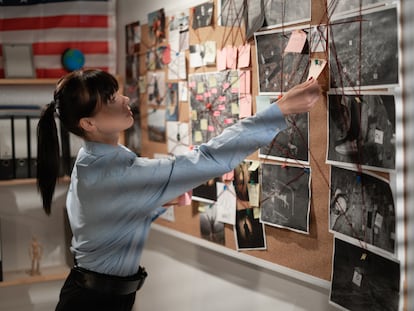Cable sobre la precariedad de un almacenamiento de material nuclear
Este telegrama detalla el mal estado de una instalación de Kinshasa en la que se almacena uranio
| ID: | 77636 |
| Date: | 2006-09-08 11:17:00 |
| Origin: | 06KINSHASA1410 |
| Source: | Embassy Kinshasa |
| Classification: | CONFIDENTIAL |
| Dunno: | 06KINSHASA1271 06KINSHASA1272 06KINSHASA1392 |
| Destination: | VZCZCXRO4954 RR RUEHHM RUEHMR RUEHPB RUEHRN DE RUEHKI #1410/01 2511117 ZNY CCCCC ZZH R 081117Z SEP 06 FM AMEMBASSY KINSHASA TO RUEHC/SECSTATE WASHDC 4746 INFO RUEHZN/ENVIRONMENT SCIENCE AND TECHNOLOGY COLLECTIVE RUEHXR/RWANDA COLLECTIVE RUCNSAD/SOUTHERN AFRICAN DEVELOPMENT COMMUNITY RUEHGG/UN SECURITY COUNCIL COLLECTIVE RHEBAAA/DEPT OF ENERGY WASHDC RUFOADA/JAC MOLESWORTH RAF MOLESWORTH UK RHMFISS/HQ USEUCOM VAIHINGEN GE RUEAIIA/CIA WASHDC |
C O N F I D E N T I A L SECTION 01 OF 02 KINSHASA 001410 SIPDIS SIPDIS E.O. 12958: DECL: 09/06/2016 TAGS: ENRG, EMIN, ETRD, KGIT, PREL, PGOV, IAEA, CG SUBJECT: SECURITY AT THE DRC'S NUCLEAR RESEARCH CENTER REF: A. KINSHASA 1271 B. KINSHASA 1272 C. KINSHASA 1392 Classified By: EconOff DPopovich for reasons 1.4 b/d/e. 1. (C) Summary. Four EmbOffs and an Econ LES toured the Kinshasa Nuclear Research Center (CREN-K) July 27 to assess security and determine its needs. CREN-K houses the DRC's two nuclear reactors, neither of which functions, although staff continue to conduct nuclear-related research and teaching at the facility. External and internal security is poor, leaving the facility vulnerable to theft. The GDRC needs international assistance to secure the facility and its nuclear materials. End Summary. Physical Layout --------------- 2. (U) July 27, Professor Fortunat Lumu Badimbayi-Matu (Lumu), the Director of CREN-K and the DRC's Atomic Energy Commission, gave four Emboffs and an Econ LES a tour of CREN-K's facility, the location of the DRC's two nuclear reactors (reftels A, B, C). CRENK-K is on approximately five acres of land on the edge of the University of Kinshasa campus, a 45 minute to one hour drive from downtown. The facility is composed of approximately five buildings. One building houses one reactor, one houses the second reactor and one acts as a small nuclear waste storage room. The remaining buildings are used as offices, research laboratories and classrooms. Nuclear Material ---------------- 3. (C) The DRC's two nuclear reactors consist of a 1959 Triga I reactor and a 1972 Triga II reactor. Neither functions. The Triga I reactor was retired in 1970, and the Triga II reactor ceased functioning in 1992 when the reactor's control center experienced an electrical problem that made it impossible to control. CREN-K also has 138 nuclear fuel rods (LEU). (Note: CREN-K originally had 140 fuel rods. Two of these, however, were stolen by unidentified thieves in 1998. Italian authorities later recovered one of these fuel rods from the Italian Mafia in Rome, who were allegedly trying to sell it to unidentified buyers in the Middle-East. The second fuel rod has never been found. End note.) 56 fuel rods are stored in the heavy water of the Triga I reactor, 74 are stored in the heavy water of the Triga II reactor. Nine others have never been used and are stored in a separate room. 4. (C) According to Lumu, the total amount of radioactive material in the Triga II reactor consists of 10.5 kilograms of non-enriched uranium (U-238) and 5.1 kilograms of enriched uranium (U-235, enriched to 20 percent). Lumu did not provide information about Triga I. 5. (C) A CREN-K technician told EconOff that the facility has approximately 23 kilograms of nuclear waste, stored in the nuclear waste storage building in four 50 gallon drums. It consists of Radium 226, neutron sources (nfi) and Cesium 137. Security -------- 6. (C) A fence approximately six feet high surrounds some of CREN-K. The fence is constructed of cement in some places and chain-link in others. The fence is not lit at night, has no razor-wire across the top, and is not monitored by video surveillance. There is also no cleared buffer zone between it and the surrounding vegetation. There are numerous holes in the fence, and large gaps where the fence was missing altogether. University of Kinshasa students frequently walk through the fence to cut across CREN-K, and subsistence farmers grow manioc on the facility next to the nuclear waste storage building. (Note: In mid March 2006, an International Atomic Energy Agency (IAEA) contractor detected elevated levels of radiation in this manioc plot using a Geiger counter. End note.) No fence separates the nuclear waste storage building and the University of Kinshasa's women's dormitory. The two buildings sit approximately 300 meters apart, and one can walk freely from one to the other across the manioc field. KINSHASA 00001410 002 OF 002 7. (C) Three security officers guard CREN-K at any one time. A team of 21 security guards, which consists of nine DRC police officers and 12 private security guards, rotate shifts 24 hours a day, 365 days per year. The guards usually stand at one of two control points of entry to the facility: the main drive-in gate or the pedestrian entrance. XXXXXXXXXXXX some are elderly, and some are occasionally caught sleeping on the job. XXXXXXXXXXXX, and both groups lack training. 8. (C) None of CREN-K's buildings have sophisticated locks, intrusion alarms, motion detectors or video surveillance systems. Once inside the facility, no one controls the entrance to the nuclear reactor, although a key is required to enter the room. The fuel rod storage room where the nine unused fuel rods are stored was not locked, and the fuel rods are not kept in a separate locked container. 9. (C) The nuclear waste storage building, which is a separate structure approximately 500 meters from the main building, is approximately 15 square meters. It was constructed of about 12 inch thick bricks, and has one iron door and several small windows near the roof. The door was locked with a standard padlock. Once through this door, there was another metal gate inside the entrance. The gate was also locked, but it was only about eight feet high, and did not reach the 16 foot high ceiling, making it possible for someone to climb over it. Beyond the metal gate is a single room approximately 32 square feet where the four 50 gallon drums containing the nuclear waste is stored against a northern wall. CREN-K Personnel ---------------- 10. (C) The DRC'S General Atomic Energy Commission (CGEA), which is under the Ministry of Science and Technology, governs CREN-K. CGEA has two divisions: technical and administrative. The technical division is responsible for running the nuclear reactor, and it is divided into four departments: Technology, Science, Biology and Nuclear Medicine. approximately 180 people work at CREN-K, about 50 of whom are scientists, 60 of whom are technicians and 70 who serve as administrative officers. According to a facility technician, their salaries range from USD 40 to 150 per month - (comment: a substantial vulnerability for the facility). Some senior officials include: -- Professor Fortunat Lumu Badimbayi-Matu, CGEA Commissioner -- Alphune Tshisonolo Tshisho, Senior Nuclear Scientist -- Dieudonne Konbele, Chief of the Technical Department -- Leonard Makontshi Woto, Radiation Control Inspector 11. (C) While neither the Triga I or Triga II reactors function, CREN-K's nuclear scientists continue to work. They conduct agricultural research (such as irradiating and mutating corn), study nuclear medicine, produce isotopes, analyze and identify neutron material, study radiography and teach University of Kinshasa students physics and nuclear science. 12. (C) Professor Lumu, who runs the facility, told Emboffs he wants to restart the nuclear reactor. Lumu has been lobbying the international community to provide the necessary funds and technology to do this. Lumu said he plans to use the reactor to study x-ray detraction, radiology, agronomy, gamma irradiation, nuclear medicine, environmental science and radiation protection. Comment ------- 13. (C) Because CREN-K's security is poor, it is relatively easy for someone to break into the nuclear reactor building or the nuclear waste storage building and steal rods or nuclear waste, with no greater tool than a lock cutter. It would also be feasible to pay a CREN-K employee to steal nuclear material. It is imperative that the international community find a way to help better secure the facility, even if GDRC remains unwilling to give up its fuel rods. Priority funding needs are new fencing, proper nuclear waste storage and disposal and security training. End comment. MEECE |
Traducción automática. Puede que el texto traducido no sea fiel al original
Tu suscripción se está usando en otro dispositivo
¿Quieres añadir otro usuario a tu suscripción?
Si continúas leyendo en este dispositivo, no se podrá leer en el otro.
FlechaTu suscripción se está usando en otro dispositivo y solo puedes acceder a EL PAÍS desde un dispositivo a la vez.
Si quieres compartir tu cuenta, cambia tu suscripción a la modalidad Premium, así podrás añadir otro usuario. Cada uno accederá con su propia cuenta de email, lo que os permitirá personalizar vuestra experiencia en EL PAÍS.
¿Tienes una suscripción de empresa? Accede aquí para contratar más cuentas.
En el caso de no saber quién está usando tu cuenta, te recomendamos cambiar tu contraseña aquí.
Si decides continuar compartiendo tu cuenta, este mensaje se mostrará en tu dispositivo y en el de la otra persona que está usando tu cuenta de forma indefinida, afectando a tu experiencia de lectura. Puedes consultar aquí los términos y condiciones de la suscripción digital.
























































